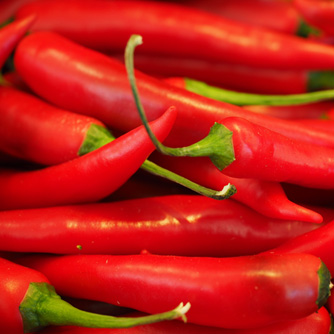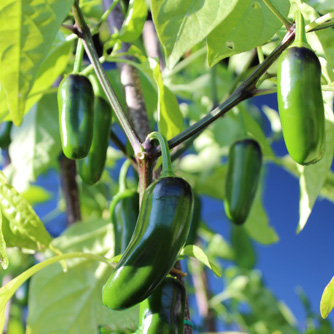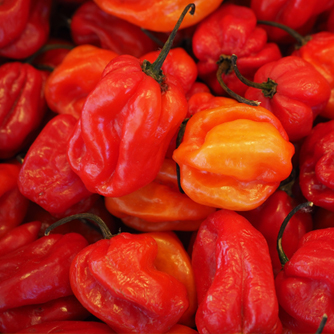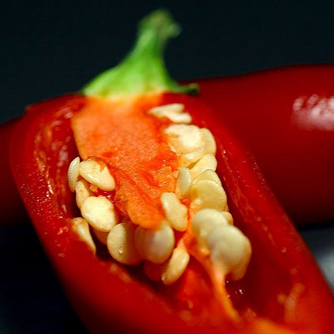Chillies
BackChillies are one of the most popular flavours used in cuisines all around the world. They come in many colours and shapes with their heat intensity ranging from mild to mind blowing! Amazingly chillies have been in cultivation for more than 6,000 years and are still one of the most consumed vegetables on the planet. Why? Our guess is because when they are eaten they stimulate the production of endorphins in the body which make us feel good.
How To Grow Chillies
Chillies are the spicy version of capsicums and are related to tomatoes, potatoes and eggplants. They like warm soils with good drainage and a hot full sun position. Prepare the soil beforehand by mixing in some cow manure, compost and certified organic pelletised fertiliser. Also apply dolomite or lime to the soil to improve calcium levels and then you’ll be ready to plant.
Chillies grow easily from seed but need warm soil to germinate (above 20 degrees). Best to sow in punnets and seedlings will emerge after 10-14 days. Plant out when they are about 10cm tall. Alternatively seedlings and established plants can be purchased from nurseries.
Obviously chillies can be planted into garden beds but they are also happy growing in pots. The great thing about pots is they can be moved around to follow the sun at different times of the year. Always use a premium quality certified organic potting mix.

The classic hot red chilli
Once planted, water in well with OCP eco-seaweed to settle your plants and get them over the transplant shock. Finish off with a thin layer of sugar cane or straw type mulch to help with moisture retention and keeping weeds at bay.
In frost prone regions chillies are treated as annuals. In warmer climates however they will grow for a couple of years before losing vigour and need to be replaced.
Sowing Guide for Chillies
| Growing Zone | Sowing Time |
| Cool Zones | Spring* |
| Mediterranean Zones | Spring*, Summer |
| Warm & Temperate Frost Free Zones | All year round |
| Tropical & Subtropical Zones | All year round |
* Protect from late frosts which will kill young plants.

Green chillies can still pack a punch!
Fertilising and Harvesting Chilli
Apply OCP eco-seaweed and OCP eco-aminogro every 2-3 weeks to encourage strong, healthy plants that will produce lots of chillies. Avoid fertilisers that are high in nitrogen as this produces too many leaves and less fruit. Reapply dolomite or lime about halfway through the growing season to give the soil another boost of calcium.
Chillies fruit quicker than the average capsicum and the more you pick the more they produce. You can harvest as soon as you see full size fruit (when green) or wait until they turn red, yellow or purple. You can also leave them on the bush to shrivel and dry and use these for chilli powder or flakes.
Be careful with harvesting fruit as the branches of chilli plants are easily broken. Use a knife or scissors to remove the chilli and leave a small stalk on the fruit. Chillies will keep longer this way. Wear gloves when picking chillies, or wash your hands immediately afterwards, as you don’t want to accidentally rub chilli into your eye or sensitive skin later on!

Distinctive shape of habanero chillies
Pests and Diseases of Chillies
Chillies are usually easy to grow plants but there are a few problems to watch out for:
- Snails and slugs - young seedlings are vulnerable to attack and should be protected with OCP eco-shield pellets.
- Whitefly – these sap suckers are easily controlled with OCP eco-oil. Spray at the first sign of these pests as their population can quickly explode.
- Mites and aphids - more sap suckers that will commonly attack chillies. Control with an organic insecticide.
- Caterpillars – caterpillars can attack the foliage and occasionally the fruit itself. Pick off the ones you see or spray with OCP eco-caterpillar killer.
- Fruit fly – these flies are immune to the chilli heat and will lay eggs in the fruit. The hungry maggots which then hatch ruin the fruit. Monitor for fruit fly with the OCP eco-lure trap and then apply a cover spray or exclusion bags as soon as they appear in the trap.
- Blossom end rot– a lack of calcium will cause the fruit to rot at the tip while still on the plant. Australian soils are commonly calcium deficient so apply dolomite or lime at planting and then midway through the growing season. It can also be caused by irregular watering during hot weather so ensure regular deep watering at all times. Apply OCP eco-hydrate to help improve water penetration and retentions.
- Root knot nematodes – these are tiny worm-shaped pests that cause terrible problems by attacking and distorting roots. Roots are unable to absorb sufficient nutrients and water so plants grow poorly and wilt in hot weather. Prevention is the key by preparing the soil with OCP eco-nemguard before planting and then reapplying every 4-6 weeks. Boosting the soil with organic matter (manure and compost) and practicing crop rotation is also helpful at keeping nematode numbers down.

Remove chilli seeds before cooking to reduce the heat factor


